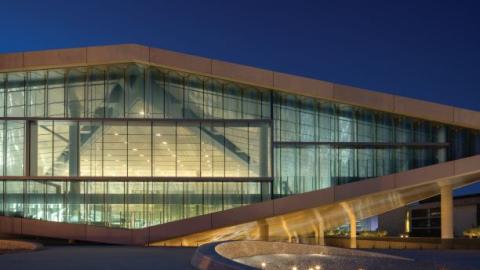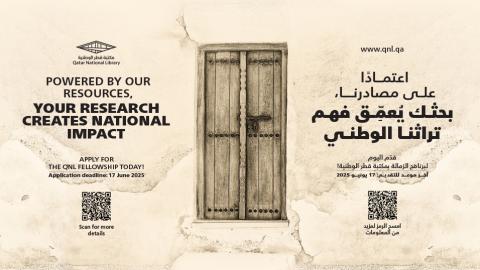
Qatar National Library is currently hosting the “Holy Kaaba Exhibition”, which depicts the history of the sacred Kaaba, situated in the center of The Great Mosque, in the city of Mecca.
Visitors to the exhibition, in the tranquil setting of the Heritage Library, have a rare chance to interact and learn from valuable historical sources including manuscripts, documents, early printed books, illustrations and photos, which evoke important events in the history of the Holy Kaaba, and highlight its spiritual impact for Muslims.
The exhibition holds special significance during the holy month of Ramadan, a time of reflection and increased devotion for Muslims. The sacred site is an essential part of day to day Muslim life, orientating the direction in which Muslims prostrate when they pray. The exhibition’s narrative states that, “The Kaaba is a place where all directions unite. In circling the Kaaba, differences of color, gender, and language disappear…”
Items on display at the exhibition such as calligraphic compositions, miniatures, illustrations, photographic prints and Qur’an manuscripts were digitized and carefully conserved by experts from the Library’s Conservation and Preservation Center.
Abeer Al Kuwari, Acting Director of Distinctive Collections at the Library, says: “The exhibition highlights the Library’s commitment to providing a repository for the region's most significant religious, cultural, and historical items. Preserving these heritage items is an important contribution to the efforts to protect Islamic history and identity, and the Library has established an environment that will preserve this information for our future generations, to learn about the origins of their religion and culture.”
Construction of the Holy Kaaba
The Holy Kaaba has been renovated, repaired, and reconstructed numerous times, and the exhibition brings together fascinating manuscripts, photos, and artefacts that record this aspect of the Kaaba, including descriptions of pre-Islamic history and traditions.
Treatise on Building the Kaaba (Morocco, 1793 CE) recounts the 11 times the sacred structure was built, with details on architectural changes to the Kaaba after the death of the Prophet Muhammad (peace be upon him), and its reconstruction during the rule of Sultan Murad IV.
History of Holy Mecca (Ottoman Printing Press Cairo, 1886 CE) is a culmination of efforts by Muslims to record the history of Mecca; a compilation of chronicles narrated by the companions of the Prophet, their successors, and scholars.
Hajj Certificates
The immeasurable religious and spiritual importance of visiting the Holy Kaaba to Muslims is reflected in the many testimonies and accounts of pilgrims which are on display. In the last two centuries, celebrating the completion of the pilgrimage through the multi-colored painted Hajj certificates, murals and works of art included in the exhibition, became more common.
The items also show how the function of the Hajj certificates went beyond simply recording the pilgrimage: “The numerous mosques, shrines and landscapes mentioned, the insertion of Jerusalem, and the naming of early Muslims evoking important and pivotal events in early Islam are proof that the purpose of these representations was also to provide a visual landscape of Islam and its early history.” Reprints were often hung on the walls of houses, mosques and madrasas as a visual reminder of the holy sites of Islam.
Non-Muslim Visions and Travel Accounts
The travel accounts by non-Muslims that are part of the exhibit offer astonishingly detailed descriptions of Mecca and the rituals of Hajj. Personal Narrative of a Pilgrimage to El-Medinah and Meccah (1855) by Sir Richard F. Burton, is a vivid narrative from one of the first English Christians to visit Mecca in 1853, and to gain access to the Kaaba.
My Journey to Makkah (Hachette Publishing, 1896) is a book of illustrations inspired by photos taken by the author, Jules Gervais-Courtellement, one of the first to photograph Mecca’s landmarks.
Architectural Features and Adornment
Another rare visual item on display is an image of the Holy Kaaba believed to be the earliest photograph taken by an Arab photographer during his visit in 1885 CE.
Many of the exhibits show visitors the ornamentation of the inside of the Kaaba. One of the artefacts is part of the ornamented curtain door of the Kaaba (the burqa) made in Egypt during the reign of King Farouk I (circa 1936 CE). According to historical accounts, the old discarded covering cloths of the Kaaba were sometimes used to make clothes, believing them to be a source of blessing. A Kaftan Made from the Interior Kiswa of the Kaaba (Turkey, circa 20th century CE) includes verses from the Qur’an about the Kaaba and the Holy Mosque.
These and other items are on display to the public at the “Holy Kaaba Exhibition,” which runs until October 1. More than 50 curated items such as ‘Translation of the Holy Qur’an’ (C. Ackers for J. Wilcox Press, London, 1734 CE), one of the most famous translations of the Qur’an into English by George Sale, that includes a sketch of the Holy Mosque.
The extraordinary exhibition is a testament to the Library’s commitment and efforts towards access and protection of the Heritage collections, through preservation, conservation, cataloguing and imaging. The collections are protected as well as made available to scholars and general interested public worldwide.
“We invite the community to come and experience the Holy Kaaba Exhibition at the Library, which reveals the deep history of this cornerstone of faith. Especially at this time of deeper religious observation, the spiritual significance of the displays becomes even stronger for visitors,” said Al Kuwari.







